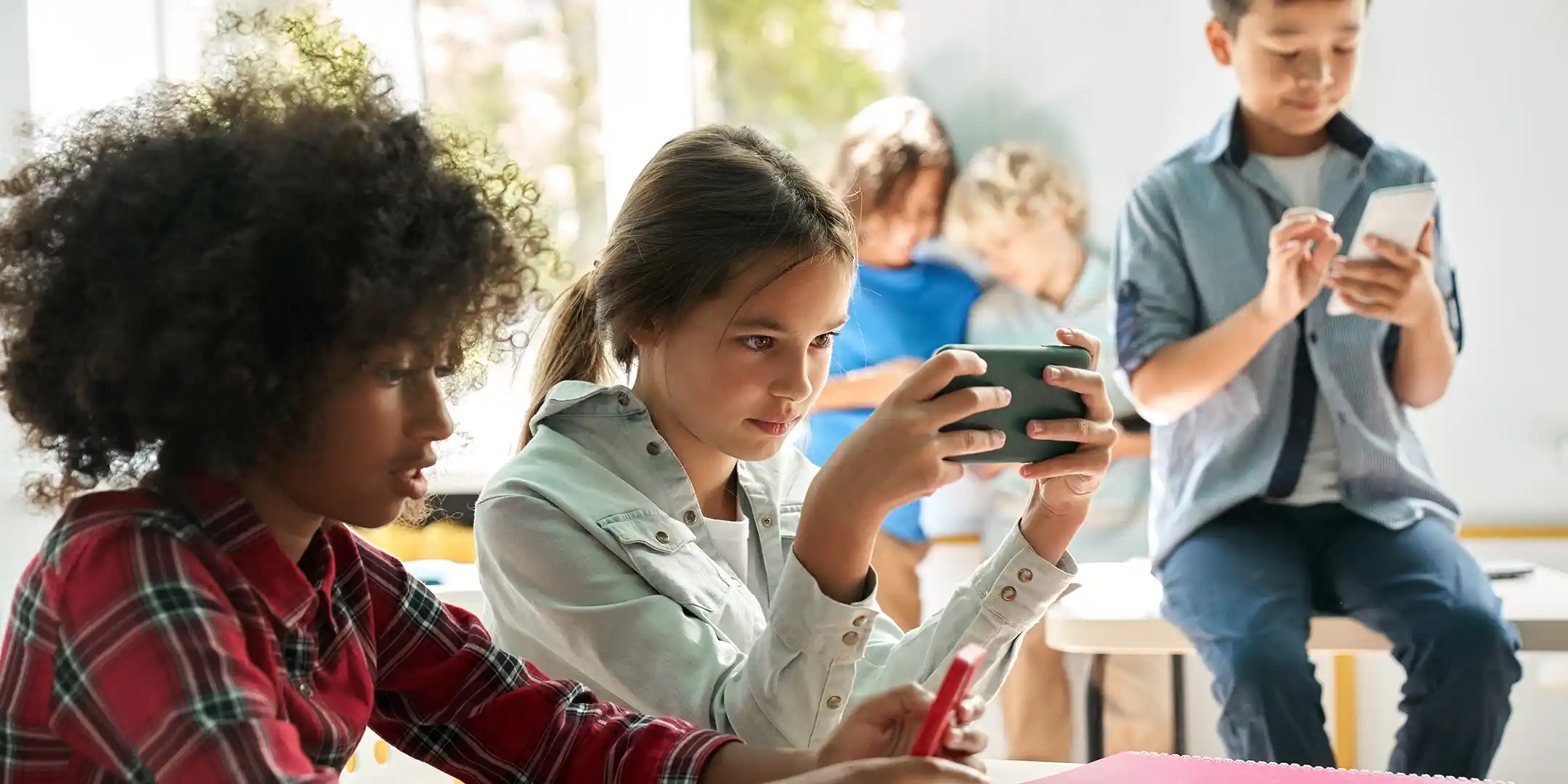Four Ways to Eliminate the Need for Cellphone Bans
Students returned to school without their cellphones in one Flint, MI school where a new policy banning cellphones on campus went into effect after winter break. They aren’t the first or only district to determine that school hallways and classrooms might be better off without that pocket-sized distraction. While we do know of some data on the affects of screen usage on students’ declining mental health, we don’t know how or if external bans are the best method to support the mental health and well-being of staff and students, or if there is there another way.
The External Problem
We live in a digital world. We pay our bills online, connect with long-distance family members on a screen, attend college classes and business meetings via platforms like Zoom. So, what would happen to our mental health if all that access was suddenly taken away? The students of this generation have working memories and residual trauma of a time in history when the main way to experience belonging and human connection outside of their homes happened through a screen. We are just beginning to see the implications of what that means for young people and their connections to their devices, and what we do know is inconclusive at best.
“There isn’t a linear relationship between screen use and mental health,” says Katherine Keyes, an epidemiologist at Columbia University’s Mailman School of Public Health. “On most surveys, teens who use their phones up to two hours a day appear healthier than those who don’t use them at all. This doesn’t count other reasons for technology use, such as homework or listening to music.” That feels hopeful until you realize that on average, children ages 8-12 in the United States spend 4-6 hours a day watching or using screens, and teens spend up to 9 hours,smartphones included. There is a better way to get to the root of the health and well-being of our students, but it might not start with external factors, bans, or rules based in fear; it’s an inside job.
The Internal Solution
There is no denying that cellphone bans cut the external distractions that are plaguing schools across the nation. However, they can also act as a band aid to avoid addressing the bigger issue at hand: lacking the self-control to say “no” to screentime temptation.
Self-control is the act of being aware of your own thoughts and feelings in a way that enables you to control your actions. When modeled and taught appropriately, self-control can be viewed “as an act of love and a choice that needs to be made repeatedly,” according to Dr Becky Bailey in Easy to Love, Difficult to Discipline: The 7 Basic Skills for Turning Conflict into Cooperation.The simple awareness of one’s own thoughts and feelings is the first step toward self-control. The hope is that through the repeated teaching and modeling of self-regulatory skills via Conscious Discipline, no student will become a slave to their impulses and insecurities (both of which appear to be fed by excessive smartphone usage).
Mastering Self-Control
Cellphone bans have become widely used, in part because bans are immediate and relatively easy to enforce. Students often lack the self-control to limit cellphone use, and bans remove the temptation entirely. Students’ brains are actively developing, and they rely on adults to co-regulate and scaffold emerging executive functions like impulse control, goal achievement and attention. If our goal is to help students acquire the self-control needed for them to limit cell phone use for themselves, then we need to look deeper than simply removing the technology. Here are four ways to support students’ emerging executive skills that naturally reduce or eliminate the need to ban cellphones.
-
Focus on What They Want to Accomplish
Remember what it was like to be a student in school? For most of us, there was limited autonomy within the walls of the school building. We were told what classes to take, where we could sit, even when we could use the bathroom. Limited autonomy means less responsibility, agency and ownership of our own learning. One way to encourage responsible cell phone usage is to start a conversation about what students want to see themselves accomplish. In the elementary school years, it might be the finishing of an art project, making a new friend or getting an A on a math quiz. In older years, students might be more focused on future education or career plans. Listen attentively as students voice their desires. Then ask what steps they might need to take to accomplish those goals. All goals take time, focus and investment. Does the accessibility of cellphones help with managing the time, focus and investment in those goals? Perhaps sometimes. But most of the time, as supported by data and backed by research, the answer is a resounding “no.” Verbally affirm your commitment to their growth as people and as scholars, and as partners in achieving their goals. Set out to create a cellphone policy or plan that fully supports their goals, and yours.
-
Celebrate Their Successes and Build a Community of Belonging
Create an inclusive, compassionate culture within the classroom. When a student feels a sense of safety and belonging, they are more likely to invest their energy in being present in their current time and space, rather than searching for connection elsewhere via their phones. This kind of intentional relationship-building is something we call a School Family, and is supported through a variety of implementation tools and events. A School Family fosters positive connections that are attributed to the lowering of anxiety and depression, and the raising of self-esteem in both children and adults (BetterHealth). Within your School Family, notice and celebrate when students use their cellphones appropriately, or when they choose not to use a cellphone at all. Students choosing to be fully present, engaged, and attentive to learning is certainly celebration-worthy!
-
See Situations from Their Perspective
As much as we like to think we know what our students are experiencing because “we, too, were young once” or because we work in the same building they learn in, it’s not the same. It’s imperative we use our powers of Attention and Perception to build trust and establish the relationships that provide the fertile ground needed to grow students’ intrinsic motivation, self-control, and self-regulation. A student’s attachment to a cellphone could stem from a million motivations, including efforts to gain popularity, avoid difficult interactions, stave off boredom, resolve transportation issues, provide a line of communication with an ailing family member, reassure anxieties over lock-down drills and safety concerns, tend to jobs or siblings they’re responsible for, or other deeply personal reasons. We don’t really know, and we don’t need to know in order to help students be successful in developing the skills like impulse control that help them to use their cellphones wisely in their unique situation. We strengthen students’ skills like self-control, impulse control and responsible decision-making when we teach and model the skill, and then allow students the opportunity to practice these skills. Seeing the situation from the student’s perspective helps us become more willing to provide them with the space to practice these emerging skills (including the inevitable missteps and failures), and eases our “need” to create blanket bans.
-
Hold Them Accountable
The beauty of making space for students to share goals and determine the path to achieve them (strategy number one in this article) is that it paves the way for educators and administrators to point back to the students’ own plan when they get off course. Students are going to make mistakes; mistakes are the hallmark of learning! Our job is to remain composed, hold them accountable to their goals, and guide them back on track.
Most of us have heard (or maybe been involved in) an escalating argument as a teacher discovers a student using a cellphone in an inappropriate or not agreed upon way. Neither feels safe nor heard as their voices rise and their body language grows more intense. A lack of self-regulation on the adult’s part shifts the focus from the student’s accountability and learning to the conflict itself—who is right, who is wrong, and who is out of line. The first step in holding students accountable for their choices is self-regulation on the adult’s part. Taking a deep breath, reminding ourselves “we’ve got this!” and focusing on helping the student be successful will help. Maintaining our composure places the responsibility for the students’ choice squarely on their own shoulders, creating a natural desire to develop the skills needed to meet their goals.
A cellphone ban isn’t going help students to invest in their own mental health and wellbeing, limit distractions, be present and engaged, and feel empowered to achieve their own goals. When we shift from the short-term goal of stopping cell phone use to the long-term goal of developing higher-order functions like self-control, responsibility, goal achievement, and impulse control, we instill the skills students need to succeed far beyond the confines of the classroom. We set students on a pathway to a lifetime of achievement. Who needs a phone for that?
To learn more about implementing Conscious Discipline in your school, classroom, or district, check out our events page often for the latest inspirational workshops, institutes, and conferences near you!
Have a question? You can now connect with live support, available on weekdays from 9 am to 5 pm. ET. Click on the blue and white thought bubble icon on the bottom right-hand side of the page to connect to a team that is waiting to help.
Sometimes questions can’t wait for working hours. From 5 pm to 9 am. ET, you can access a custom Conscious Discipline chatbot designed to assist you with our most common support requests. If your question requires more personal support, select the “Contact” button to send your inquiry to the appropriate team and someone will get back to you.
There’s so much happening with Conscious Discipline in 2024! To keep up with our latest news follow us on…
Facebook: https://www.facebook.com/ConsciousDiscipline
Instagram: https://www.instagram.com/consciousdiscipline/
Threads: https://www.threads.net/@consciousdiscipline
TikTok: https://www.tiktok.com/@consciousdiscipline
Pinterest: https://www.pinterest.com/consciousd/
LinkedIn: https://www.linkedin.com/company/conscious-discipline-llc/
YouTube: https://youtube.com/@ConsciousDisciplineVideos
X: https://twitter.com/ConsciousD
____________________________________________________________________________________
Resources
Articles:
Products:
Easy to Love, Difficult to Discipline: The 7 Basic Skills for Turning Conflict Into Cooperation
Podcasts:
Creative Strategies to Inspire Hesitant Teachers
Events:
Conscious Discipline for Administrators
Upcoming Educator Events:
Ft. Lauderdale, FL Teacher Event
Palm Springs, CA Teacher Event
Teacher Event in Nashville, TN 2024
Teacher Event in St. Louis, MO 2024




